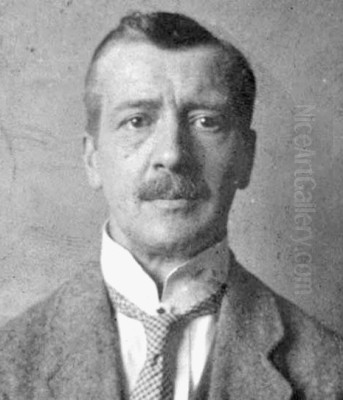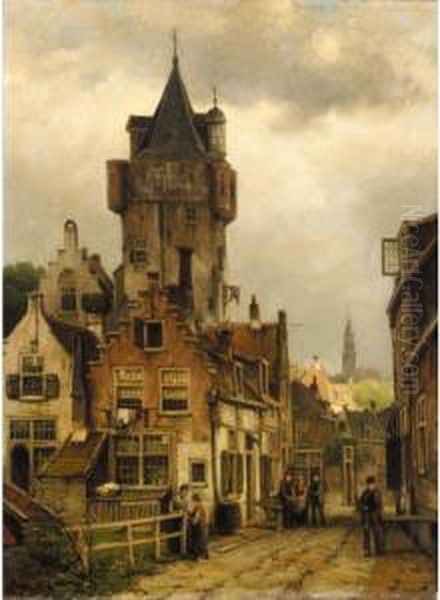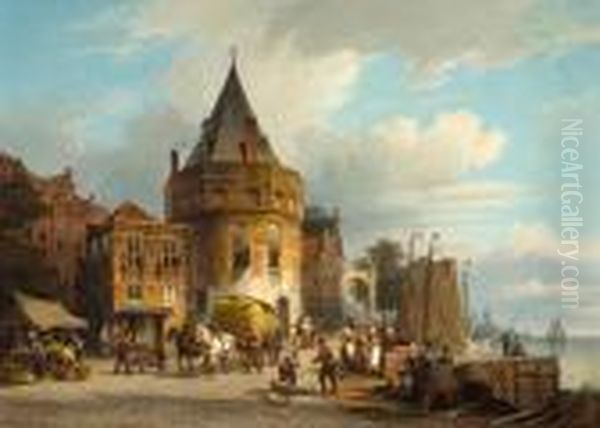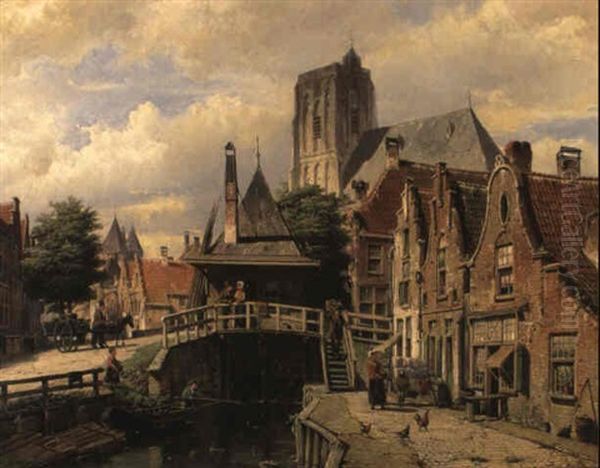
Willem Koekkoek stands as a significant figure in nineteenth-century Dutch art, celebrated primarily for his meticulously detailed and atmospheric paintings of townscapes. Born into arguably the most famous dynasty of painters in the Netherlands, he carved a unique niche for himself, diverging from the landscape and marine specialisms of his relatives to become the pre-eminent urban view painter of the Koekkoek family. His work captures the charm and character of Dutch towns and cities with a romantic sensibility, preserving a vision of urban life that continues to captivate viewers today.
Born on January 3, 1839, in the bustling city of Amsterdam, Willem Koekkoek entered a world already steeped in artistic tradition. He passed away on January 29, 1895, in Nieuwer-Amstel (now Amstelveen), leaving behind a substantial body of work that cemented his reputation. His life spanned a period of transition in Dutch art, bridging the gap between the established Romantic tradition and the emerging Hague School, though his own style remained firmly rooted in the detailed realism and idealized atmosphere of Romanticism.
A Family Legacy: The Koekkoek Dynasty
Understanding Willem Koekkoek requires acknowledging the formidable artistic dynasty he belonged to. The Koekkoek family produced painters across four generations, starting with Willem's grandfather, Johannes Hermanus Koekkoek (1778-1851), a respected marine painter. The family's artistic fame reached its zenith with Willem's uncle, Barend Cornelis Koekkoek (1803-1862), often hailed as the "Prince of Landscape Painting," whose romantic forest scenes and winter landscapes achieved international acclaim and commanded high prices.
Willem's father was Hermanus Koekkoek the Elder (1815-1882), himself a highly successful marine and river scene painter. Hermanus Sr. provided Willem with his initial artistic training, grounding him in the family's tradition of technical proficiency and careful observation. Other notable artistic relatives included Willem's uncle Marinus Adrianus Koekkoek (1807-1868), also a landscape painter, and his brothers, Hermanus Koekkoek the Younger (1836-1909), who became an art dealer in London as well as a painter, and Johannes Hermanus Barend Koekkoek (1840-1912), known as 'Jan H.B.', who painted marines and coastal scenes. Willem's cousin, Hendrick Pieter Koekkoek (1843-c.1890), son of Marinus Adrianus, also pursued landscape painting.

Within this extensive network of landscape and marine specialists, Willem Koekkoek's decision to focus almost exclusively on townscapes set him apart. While his family members depicted the grandeur of nature or the drama of the sea, Willem turned his attention to the built environment, capturing the intricate facades, bustling streets, and tranquil canals of the Netherlands' urban centres. This specialization allowed him to develop a distinct artistic identity while still benefiting from the family's reputation and network.
Early Life and Artistic Formation
Growing up in Amsterdam, Willem was immersed in art from a young age. His primary instruction came directly from his father, Hermanus Koekkoek the Elder. This apprenticeship within the family studio would have provided a rigorous grounding in drawing, composition, and oil painting techniques, emphasizing the meticulous detail and fine finish characteristic of the Koekkoek school. The family environment itself served as a continuous source of learning and inspiration, with constant exposure to the works and discussions of his father, uncles, and brothers.
While some sources suggest formal training at the Rijksakademie van beeldende kunsten (Royal Academy of Fine Arts) in Amsterdam, his primary formation seems rooted in the family workshop tradition. Regardless of formal academic attendance, the artistic standards within the Koekkoek circle were exceptionally high. Willem absorbed the prevailing Romantic aesthetic, which valued mood, atmosphere, and an idealized representation of reality, even when depicting specific locations.
His public career began relatively early. Willem Koekkoek first exhibited his work in 1859 in Leeuwarden. This marked the beginning of a consistent presence in Dutch art exhibitions. From 1865 until 1894, shortly before his death, he regularly showed his paintings at the major annual exhibitions held in Amsterdam, The Hague, and Rotterdam, known as the 'Tentoonstelling van Levende Meesters' (Exhibition of Living Masters). This consistent visibility helped establish his reputation among collectors and critics.
Developing a Unique Vision: The Cityscape Specialist
Willem Koekkoek's true artistic contribution lies in his dedication to the Dutch townscape. He travelled throughout the Netherlands, sketching and observing the unique architectural character of various cities and towns. His favoured subjects included the historic centres of Amsterdam, Rotterdam, Utrecht, Delft, Gouda, Enkhuizen, Oudewater, and Ijsselstein, among others. He was particularly drawn to the interplay of brick and stone architecture, the reflections in canals, and the way sunlight illuminated street scenes.

His repertoire included both summer and winter views. Summer scenes often feature sun-drenched streets, leafy trees casting shadows on warm brickwork, and figures engaged in daily activities – chatting, strolling, or tending to shop fronts. These works convey a sense of peaceful, prosperous urban life. His winter scenes are equally evocative, depicting snow-covered roofs, frozen canals bustling with skaters and sleds, and the crisp, clear light of a cold day. These paintings capture the picturesque charm of Dutch winters, a theme popular since the 17th century.
Beyond the Netherlands, Koekkoek also occasionally depicted scenes in Belgian cities, such as Bruges, known for its well-preserved medieval architecture, which resonated with his romantic sensibilities. Whether depicting Dutch or Belgian settings, his focus remained consistent: capturing the enduring character and atmospheric charm of historic urban environments. He often included recognizable landmarks, such as the Schreierstoren in Amsterdam, but his primary interest lay in the overall composition and mood of the street or canal scene.
Artistic Style and Technique
Willem Koekkoek worked firmly within the Dutch Romantic tradition, which looked back with nostalgia to the Golden Age of the 17th century while infusing scenes with heightened atmosphere and sentiment. His style is characterized by exceptional technical skill, particularly evident in his meticulous rendering of architectural details. Brickwork, stone textures, window frames, roof tiles, and decorative gables are all depicted with painstaking accuracy and a fine brushstroke.
His handling of light and shadow is a key element of his artistry. Koekkoek often favoured scenes bathed in the warm glow of afternoon sunlight, creating strong contrasts between illuminated facades and shaded areas. This use of chiaroscuro adds depth and drama to his compositions, enhancing the three-dimensional quality of the buildings and highlighting textures. Reflections in the water of canals were another area where he demonstrated considerable skill, capturing the shimmering, distorted images of buildings and boats.
Koekkoek populated his townscapes with small figures, known as staffage. These figures, often dressed in contemporary 19th-century or sometimes slightly historicized attire, serve multiple purposes. They add a sense of scale to the architecture, inject life and narrative interest into the scene, and contribute to the overall atmosphere. The figures are typically engaged in everyday activities, reinforcing the impression of a living, breathing city.

A fascinating aspect of Willem Koekkoek's work is his tendency to create composite views, sometimes referred to as architectural capriccios. While often depicting recognizable buildings or capturing the general character of a specific town, he would sometimes rearrange architectural elements or combine buildings from different locations into a single, idealized composition. This practice allowed him to create perfectly balanced and aesthetically pleasing scenes, prioritizing artistic harmony over strict topographical accuracy. This approach aligns him with a tradition dating back to Italian veduta painters but adapted to a distinctly Dutch context.
His style shows a clear lineage from the great Dutch cityscape painters of the 17th century, such as Jan van der Heyden (1637-1712) and Gerrit Berckheyde (1638-1698). Like them, Koekkoek emphasized detailed realism, architectural accuracy (even within his composite views), and the atmospheric effects of light. However, his work possesses a distinctly 19th-century Romantic sensibility, often imbued with a greater sense of nostalgia and picturesque charm than his Golden Age predecessors.
Contemporaries and Influences
Willem Koekkoek operated within a vibrant Dutch art scene. His most significant contemporary and, in some ways, rival in the specific genre of townscape painting was Cornelis Springer (1817-1891). Springer was also highly acclaimed for his detailed and atmospheric city views, often depicting identifiable historical buildings with great accuracy. While both artists shared a meticulous technique and a romantic appreciation for Dutch heritage, Springer's work is often considered more topographically precise, whereas Koekkoek allowed himself more freedom in composing idealized scenes. Their works were, and still are, frequently compared.
Another contemporary specializing in similar themes was Adrianus Eversen (1818-1897), whose townscapes also exhibit fine detail and an appreciation for the picturesque qualities of Dutch cities. Charles Leickert (1816-1907), though born in Brussels, worked extensively in the Netherlands and was renowned for his winter landscapes and townscapes, often featuring skaters, sharing thematic ground with Koekkoek's winter scenes. Johannes Bosboom (1817-1891), primarily known for his atmospheric church interiors, was part of the same generation exploring architectural themes within a Romantic framework.
The influence of Willem's own family, particularly his father Hermanus Koekkoek the Elder and his celebrated uncle Barend Cornelis Koekkoek, was fundamental. B.C. Koekkoek, through his academy in Kleve, Germany (just across the Dutch border), also influenced a generation of landscape painters, including students like Frederik Marinus Kruseman (1816-1882), whose detailed Romantic landscapes share a similar aesthetic sensibility, even if focused on rural rather than urban scenes. Willem Bodeman and Paul Joseph Constantin Gabriel were other artists associated with B.C. Koekkoek's circle.

While Willem Koekkoek maintained his Romantic style, other movements were developing during his career. The Hague School, with artists like Willem Roelofs (1822-1897), Jacob Maris (1837-1899), and Anton Mauve (1838-1888), began to favour looser brushwork and a more naturalistic, tonal approach to landscape, moving away from the detailed finish of the Romantics. Johan Barthold Jongkind (1819-1891), though spending much time in France and influencing the Impressionists, also painted Dutch scenes and represented a bridge towards modernism. Willem Koekkoek's interaction with his cousin Hendrick Pieter Koekkoek in London also placed him within a broader European context.
Career Path and Travels
Willem Koekkoek's professional life involved several relocations within the Netherlands, likely driven by artistic opportunities and personal circumstances. After his initial period in Amsterdam, he is recorded as living in The Hague in 1878. By 1880, he had returned to Amsterdam. From 1885 onwards, he settled in Nieuwer-Amstel, a municipality bordering Amsterdam (now Amstelveen), where he remained until his death in 1895. These moves suggest an artist actively engaged within the main Dutch art centres.
His travels were not limited to the Netherlands. Koekkoek spent time in London, notably visiting in 1888. Some sources suggest he may have lived there for periods, possibly facilitated by his brother Hermanus Koekkoek the Younger, who ran an art gallery in London specializing in works by the Koekkoek family. London was a major market for Dutch art, and time spent there would have exposed Willem to British tastes and potentially expanded his network of patrons. His cousin, Hendrick Pieter Koekkoek, also worked in London. This international exposure likely contributed to his success with foreign collectors.
Throughout his career, Koekkoek maintained a steady output of paintings and continued to exhibit regularly in the Netherlands. His works found favour with the Dutch bourgeoisie and aristocracy, as well as with collectors abroad, particularly in Britain and America, who appreciated the picturesque and highly finished quality of his townscapes. His participation in exhibitions, including one at the Amsterdam Royal Academy where he reportedly won an award, solidified his standing in the art world.
Notable Works
While specific titles often vary or are descriptive, certain subjects and compositions are representative of Willem Koekkoek's oeuvre. Paintings titled A Street Scene in Amsterdam or View of Amsterdam are common, often depicting bustling canals lined with characteristic gabled houses. The Schreierstoren, a 15th-century defensive tower in Amsterdam, was a landmark he painted on several occasions, capturing its imposing form against the backdrop of the city and canals.

A Summer Street Scene in Enkhuizen exemplifies his ability to capture the tranquil atmosphere of a sunny day in a historic Dutch town. Such works typically feature meticulously rendered brick facades, figures enjoying the weather, and perhaps a glimpse of a canal or church tower in the distance. Similarly, views of Gouda, Ijsselstein, Breda, or Utrecht showcase his skill in differentiating the unique architectural styles and atmospheres of various locations, even when employing his characteristic idealized compositional approach.
Winter scenes, often generically titled A Dutch Winter Landscape with Skaters or Winter Scene in a Dutch Town, are among his most popular works. These paintings excel in depicting the effects of snow and ice, the reflections on frozen canals, and the lively activity of figures skating, sledding, or conversing in the cold air. The contrast between the crisp white snow, the dark bare branches of trees, and the warm tones of brick buildings creates visually appealing compositions.
His works are consistently characterized by their high level of detail, balanced composition, and atmospheric quality. Whether depicting a well-known landmark or a more generic street view, Koekkoek aimed to create an engaging and aesthetically pleasing image that celebrated the enduring charm of Dutch urban heritage.
Reception and Legacy
During his lifetime, Willem Koekkoek achieved considerable success and recognition. His paintings were sought after by collectors who valued their technical brilliance, charming subject matter, and connection to the esteemed Koekkoek name. His work appealed to the prevailing taste for Romanticism and the picturesque, offering idealized yet recognizable views of Dutch towns that evoked national pride and nostalgia. The combination of detailed realism and romantic atmosphere proved a winning formula.
His paintings were seen not only as works of art but also, to some extent, as valuable records of Dutch towns and cities during a period of gradual modernization. Although he sometimes took liberties with topography for compositional purposes, his accurate rendering of architectural styles and details provides insight into the appearance of these urban environments in the latter half of the 19th century.
Today, Willem Koekkoek's works are held in various public and private collections. The Rijksmuseum in Amsterdam holds examples of his work, confirming his national importance. Other Dutch museums focusing on 19th-century art or regional history may also house his paintings. Internationally, his works appear in collections, although verification is needed for specific major museums sometimes cited (e.g., the National Gallery, London, primarily holds works by B.C. Koekkoek; MoMA is highly unlikely). His paintings frequently appear on the art market, where they continue to command respectable prices, testifying to their enduring appeal.
Within the broader narrative of Dutch art history, Willem Koekkoek is recognized as a leading exponent of the Romantic townscape. While perhaps overshadowed internationally by his uncle B.C. Koekkoek or by the later innovations of the Hague School, he holds a secure place as a master of his chosen genre. His unique focus within the Koekkoek dynasty and his consistent dedication to depicting the Dutch urban scene make him a significant figure. The potential controversy regarding his composite views is now often seen as part of his artistic method, creating idealized rather than strictly documentary images.
Conclusion
Willem Koekkoek remains a highly regarded painter of the Dutch Romantic era, celebrated for his specialized focus on townscapes. As a member of the illustrious Koekkoek dynasty, he built upon the family's tradition of technical excellence while forging his own path through his choice of subject matter. His paintings offer meticulously detailed, atmospherically rich visions of Dutch cities and towns, capturing their architectural character and the rhythms of urban life in both summer and winter.
His skillful handling of light, his precise rendering of detail, and his ability to evoke a sense of place—even when composing idealized scenes—define his artistic contribution. While contemporaries like Cornelis Springer pursued similar themes, Koekkoek's work possesses its own distinct charm and sensibility. His paintings serve as enduring windows onto a romantically envisioned 19th-century Netherlands, securing his legacy as a master of the Dutch urban landscape.